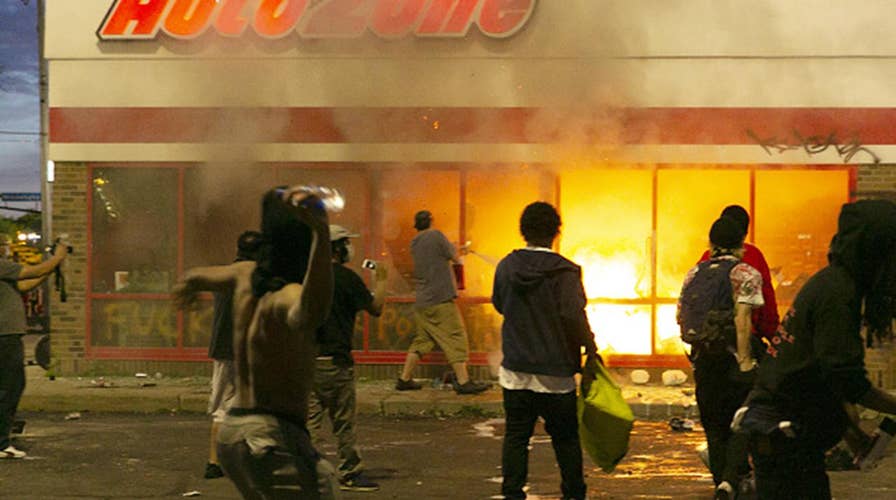Rioters using Floyd's death to destroy democracy: Kiron Skinner
Fox News foreign policy contributor Kiron Skinner says people are using George Floyd's death as a means to act in ways that have nothing to do with race, democracy and justice.
As demonstrators in the nation’s capital chanted the name of George Floyd Tuesday night, a single protester climbed a light post and took down a street sign. The crowd booed. Some threw bottles at him; others tried to grab him before he jumped down and disappeared into the crowd. But a chant soon went up: “Peaceful protest,” and the crowd eventually calmed.
Low-tech methods to try maintaining the peace, in contrast with how other leftists groups may be involved in a more sophisticated planning operation, are part of several efforts around the country that aim to quell tension — and therefore potential violence — at protests, while encouraging folks to march and speak their minds about the deaths of Floyd, Breonna Taylor, Ahmaud Arbery and other African Americans. With daily protests around the United States in dozens of cities — some stretching for a week and showing no sign of slowing — organizers say it’s essential to de-escalate any conflict and to avoid theft, vandalism and clashes with police.
These kids along with cops are trying to prevent violence from hijacking protests.
CORONAVIRUS: WHAT YOU NEED TO KNOW
Some groups, such as Black Lives Matter, have years of experience protesting and use training and proven strategies: fluorescent vests or colored ribbons to designate legal aid, volunteer medical help or peacekeepers who can try to diffuse spats on the spot. Other people are creating more informal networks as protests pop up in new corners of their cities and states daily, with many attendees who’ve never protested before.
“We want to be vocal and peaceful at the same time. Those two do coexist,” said Bruce Wilson, of South Carolina. “As soon as you throw a bottle, your message is gone.”
He and about 20 others met briefly before protests in Greenville over the weekend to discuss strategies. He urged his group to carefully study fellow protestors and be mindful if someone appeared extremely agitated.
“You can look at someone and tell they’re about to cross the line,” he said. Like Aguayo, he offers snacks, water, and the space to speak. “I tell them, ‘I feel the same way you feel.’ You have to lead by example.”
In Tampa, Black Lives Matter organizers over the weekend had nearly 100 safety marshals in fluorescent vests patrolling their march, trained in de-escalation tactics and ordered to be on the lookout for antagonists. The group also had medics, used walkie talkies to identify and squelch outbursts, and enlisted lawyers and others with legal training to watch out for protesters’ rights from the sidelines.
“We wanted to be able to provide a safe space for their voice and rage to be heard within a controlled environment. It’s part of their amendment rights for them to be able to express themselves,” said Chaikirah Parker, who helped organize the event.
The veteran activist said they purposely held the event early Sunday, despite sweltering heat. Afterward, a younger crowd held another protest, and she said the veteran activists felt obliged to help.
“We really feel it’s our duty to pass the torch and teach the kids how to organize,” she said. “They’re cocky, and then they realize the rapid response organization is a whole other level.
“You need some of everybody to move the mission forward … you need the yard dogs, but you also need the diplomacy.”
In Cincinnati, as hundreds of protestors marched to City Hall, safety marshals wore their fluorescent vests, and some toted bullhorns. Organizers with newly formed Coalition of Queen City occasionally stopped the crowd to make sure the volunteer marshals remained at the front, protester Abbey Smith said.
As the group approached an intersection, a police car tried to push its way forward. The marshal calmly positioned herself at the bumper, between the patrol car and the crowd. The officer inside gestured for the marshal to get out of the way.
“The marshal just stood there and held their hands up and kept shaking their head at them, like ‘No I’m not gonna move’ while everybody passed,” Smith said. With the marshal’s guidance, the crowd and officer moved on without incident.
“Having the people there who were very clearly making sure that we were safe also helped make things feel peaceful,” Smith said. “When you feel like people are making sure that you’re safe, it’s easier to just focus on the message that you’re trying to convey.”
CLICK HERE FOR COMPLETE CORONAVIRUS COVERAGE
When Berto Aguayo heard that Chicago protests started turning violent over the weekend, he called a few dozen people to meet in front of a colorful mural in a South Side neighborhood.
“Number one, we are here to peacefully protect small businesses,” Aguayo — co-founder of Increase the Peace, a community organizing group in the city — told the small crowd. He said the businesses were locally owned, and residents relied on them: “That is it. If somebody is trying to loot, don’t greet them with hostility. Ask them if they want water, a snack, engage in dialogue. If that doesn’t work, don’t put your life at risk.”
There was no formal training, just a pep talk and a short prayer. Then the group took its place in front of one street’s storefronts, many of them immigrant-owned: mom-and-pop grocery stores, restaurants and a homeless youth shelter.
Aguayo, a former gang member and activist for many Chicago issues, said the group was successful in helping to maintain calm that day.
The Associated Press contributed to this report.


























